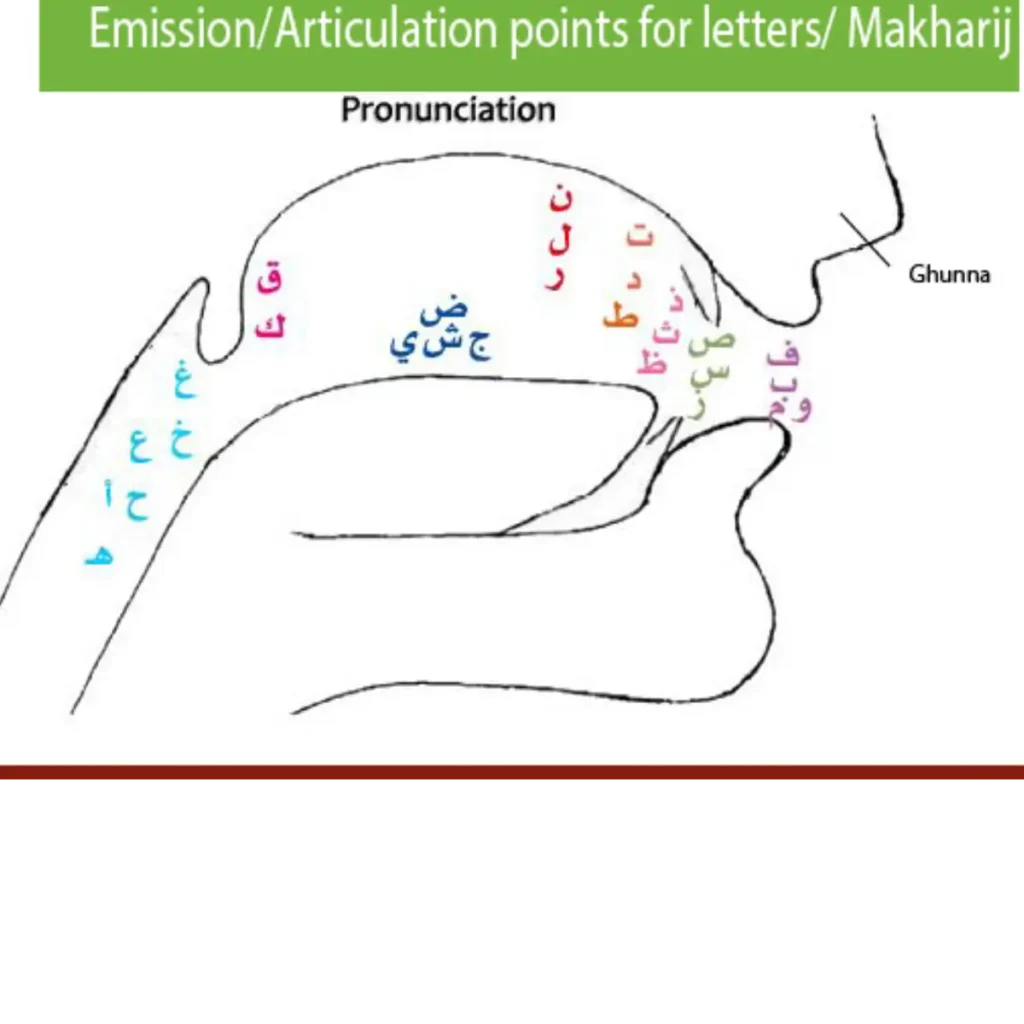Pronunciation (Makharij)

Makhraj/Makharij is the Basis of Tajweed. All rules of Tajweed rely on it because these are emission points for letters(huruf). Reading with proper Pronunciation (مخارج Emission) means using the correct position of the organs of speech to produce the accurate sound of a message (hurf). So that each sound is different from the others. However, rules apply to both consonant and vowel letters Foundation of tarweed is to recite letters correctly. The exact Pronunciation can also be achieved by learning and practising where the sound originates for each letter. The Arabic language has 29 letters or huruf. The emission point for each letter lies in the specific part of organs of speech. Like nose, tongue, and throat. All positions are discussed in detail below:
There are 5 main categories of Pronunciation (مخارج Emission):
- The oral cavity /Al Jawf
- The throat /Al Halq
- The tongue /Al Lissaan
- The lips /Ash-shafatain
- The nasal cavity
Pronunciation (مخارج Emission) Points

Al-Jawf ( The oral cavity)
The oral cavity اﻟﺠَﻮف is all the space from the chest to the throat and out through the mouth. It is the makhraj of the elongated letters /madd, also called as long vowels. These letters are elongate for two counts:
- Alif (ا ) is preceded by a fatha(zbar).
- Yaa ( ي ) preceded by a kasra(zeer).
- Wow ( و ) advanced by a dammah(pesh).
Al-Halq (The Throat)
There are six letters whose Makraj is in the throat. These are called “Huruf e Halqi.” These letters have three further categories.
1. Aqsal Halq (The deepest/ bottom part of the throat)
Haa هـ and Hamza ء Makhraj is in the deepest part of the throat. Hamza has a slight jerk.
2. Wasatul Halq (Middle of the throat)
Ayn ع and Haa ح have Makhraj from the middle of the throat. For Ayn, no airflow while for Haa airflow through the throat.
3. Adnal Halq (Top of the throat)
Khaa خ and Gyan غ Makhraj is from the top of the throat.
Al-Lissaan (The tongue)
The tongue اﻟﻠِّﺴَﺎن is Makraj for many letters that why also known as a tool of speech. Tongue with its connection with different areas of mouth and teeth is makraj of 18 out of 29 huruf. There are four main makhraj from tongue Deepest part, Middle part, Sides, and The tip of the tongue and also have ten sub-categories.
The Aqsa-al-Lisaan or deepest part of the tongue
It has two articulation points:
- Qaaf ق makhraj is the extreme back of the tongue touching the upper palate to create a thick sound in the tonsils area, with a round tone.
- Kaaf ك Makharij slightly in front of the Qaaf, but, the tongue should not meet the upper palate. Moreover, the tongue is not elevated though sound comes from the back of the tongue.
The Wast-al-Lisaan or Middle of the Tongue
It has one articulation point which covers 3 huruf:
- Jeem ج, Yaa ي, Sheen ش are articulate when the middle part of the tongue comes in contact with what lies opposite to it from the roof of the mouth. That is when the central portion of the tongue collides the roof of the mouth.
The Haafat-al-Lisaan or The side of the Tongue
It has 2 specific points of Pronunciation (مخارج Emission):
- Dhaad ض emission point is from the one or both sides of the tongue, the molars, and the gum area next to the molars. Make use of the posterior two-thirds of the side of the tongue. This letter can be articulated from one either side of the tongue, or both sides of the tongue simultaneously.
- Laam ل is pronounced from the front edge of the tongue touching the back gums of the upper six teeth.
The Taraf-ul-Lisaan or tip of the Tongue
Tua ط, Taaت, Daal د, Letters below are articulated from the tip of the tongue, touching the base of the upper incisors(top front teeth/place where gums and teeth meet) all have nearly same Pronunciation (مخارج Emission). The slight difference between there makhraj is as below:
Taa makhraj is most forward and is exactly from the point where teeth and gums meet.
Daal Pronunciation (مخارج Emission) is a slightly further back.
Tua Is behind the Daal. It is a thick letter therefore The back of the tongue should meet the upper palate.
Seen, Zaa, Suad,
- Zaa ز Makraj is when the teeth are pressing together in the way that the air passage produces buzzing sound.
- Seen س For uttering it, The tip the tongue and gums of lower teeth meet, allow air to flow in the mouth, and leave from between teeth. So it will produce a whistling sound.
- Suad/Duad ص It is a thick letter, so it Makraj is when The back of the tongue elevates to collide with the upper palate.
Zua, Dhaal, Thaa
- Thaa ث – Is pronouncing by putting pressure on the edges of the upper incisor teeth of both jaws. Be careful that there is no whistling sound-producing.
- Zua ظ – Is articulating by putting pressure on the edge of the roots of the upper incisor’s teeth. So the back of the tongue elevates to meet the upper palate as it is a thick letter.
- Zhaal ذ Is pronouncing by putting pressure on the mid-section of the upper incisor teeth of both jaws.
Raa
Raa ر its Makraj is when the tip of the slightly rolled tongue including the back touches the gums of the upper front teeth.
Noon
Noon ن Makraj is when the tip of the tongue meets the roots of the upper incisors sharing nasal passage.
The lips Ash-shafataan
The lips اﻟﺸَّﻔَﺘﺎن Makraj has also two categories:
Inside lower lip:
Faa ف is pronouncing when the edge of the upper incisors meets the wet part inside the lower lip.
Between lips:
- Wow و It is pronouncing by the incomplete joining of upper and lower lips.
- Meem م Its Makraj is the meeting of the dry outer parts of the lips. So air is pushing through the nasal passage.
- Baa ب Pronunciation (مخارج Emission) is by pressing the wet part of the lips quickly. There is a slight bounce as it is releasing swiftly
The nasal cavity al-Khayshoom اﻟﺨَﻴﺸُﻮم
The nasal cavity اﻟﺨَﻴﺸُﻮم is located from opening of nose to inside opening to mouth. So Ghunna Makrij exit at the point where it is the opening of nose to mouth. Ghunna is a resonated sound that is producing without tongue, And its duration is two counts. So Meem and Noon Sound use a nasal passage. Its Pronunciation (مخارج Emission) is also practicable.
